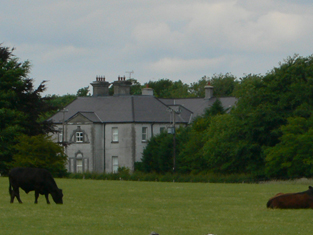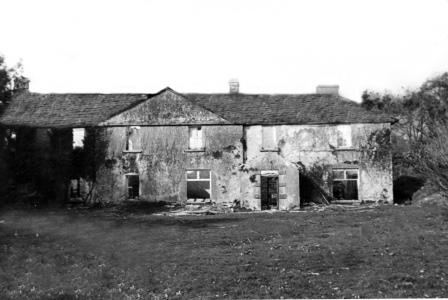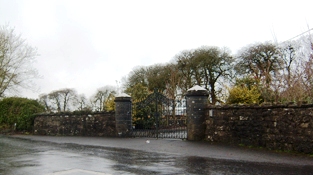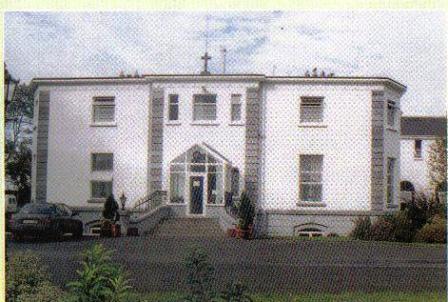Baunmore
Houses within 10km of this house
Displaying 26 houses.
Houses within 10km of Baunmore
Displaying 26 houses.
| House name | Description | |
|---|---|---|
| Ballyglunin | An 18th century house with 19th century additions, occupied by the Blake family for over 2 centuries. It is still extant and run as a conference centre. |

|
| Corrofin Lodge | At the time of Griffith's Valuation held by Pierce Blake in fee. The house was valued at £16. Some ruins remain at the site. |

|
| Annagh | In 1786 Wilson refers to Annagh as the seat of Mr. Bodkin. It was held in fee by Robert Bodkin at the time of Griffith's Valuation when the buildings were valued at £25. Annagh was the seat of M. Bodkin in 1894. The original house is no longer extant but old and extensive farm buildings still remain as well as an occupied house built in 1967. |

|
| Ardskeamore | The original house was occupied by the Brownes in the 1830s. Charles Kelly was leasing from James Browne in the 1850s when the valuation of the house was £10. By the 1890s this had been replaced by the existing house (M437420) which was renovated in 2006. | |
| Winterfield House | Described in the 1830s as a neat 2 storied house, the home of Captain Butler. It was held in fee by John Butler at the time of Griffith's Valuation, when it was valued at £15. It is no longer extant. | |
| Derrymaclaughna | A house appears to be located near the castle on the first Ordnance Survey map of 1838. The Ordnance Survey Name Books mention the ruins of a castle, a mansion house and a chapel in the townland. The property belonged to the Burke family in the 18th century as Wilson noted it as the seat of Mr. Burke in 1786. It became the residence of Thomas P. O'Flahertie of the Lemonfield family in the early 19th century. He was married to a daughter of Ulick Burke of Derrymaclaughna. At the time of Griffith's Valuation it was occupied by Thomas Cullinane who held it from James Browne. Derrymaclaughna was the residence of Alan Parker Close in the 1870s. In November 1887, Richard Rowland was offering for sale a quarter share of the lands at Errew, county Mayo, as well as lands at Derrymacloughna, barony of Clare, county Galway, in the Land Judges' Court. However, due to absence of bidding, the sale was adjourned. |

|
| Kilroe | The Hanley family were living at Kilroe in the early 19th century and it was the residence of John J. Gunning in the latter half of the 19th century. He had a mill closeby at Inish. |

|
| Cahermorris | Occupied by Cecil Crampton in the mid 19th century. Two generations of Cramptons were rectors of Headford in the 18th century. A house still exists at the site as well as a fine entrance gateway. |

|
| Dennistown House | Built post 1838, occupied by Hugh Craven at the time of Griffith's Valuation and a centre for the Agricultural Institute in the late 20th century. | |
| Cregg Castle | Built in the mid 17th century, the home of the Kirwans until the early 19th century. In 1786 Wilson mentions that it was the last castle to be built in county Galway and that it had lately been remodelled by Mr. Kirwan. Later occupied by a branch of the Blake family. It was held in fee by Francis Blake at the time of Griffith's Valuation, when it was valued at £40. Slater notes it as the residence of Mrs. Blake in 1894. Sold by the Blakes in 1947 to the Johnstons, who made alterations and restored it. Bought by the Murrays in the early 1970s, who ran it as a guest house. Sold again in 2006. |

|
| Waterdale | This was originally a Staunton property which passed by marriage to the Lamberts. In 1786 Wilson refers to it as the seat of Mr. Staunton. The OS Name Books record it as the property of James Blake in the 1830s. Sold to Lord Clanmorris briefly in the 1850s and repurchased by James Staunton Lambert, Waterdale was leased to John Wilson Lynch 1857-1870 and to James Delahunt 1870-1883. It was taken over by the Land Commission in 1903 and demolished. |

|
| Ballybanagher | A Nolan family home, now a ruin. It was held in fee by Andrew Nolan at the time of Griffith's Valuation when it was valued at £12. In 1894 Slater recorded it as the seat of Christopher R. Browne. |

|
| Annaghdown | A house at this site on the First Edition Ordnance map is labelled Annaghdown House. The current house was built in 1868 by the Blake family It is still occupied and well maintained. |

|
| Ballinduff Lodge | A Skerrett home in the 18th and 19th centuries. It is labelled Ballinduff Lodge on the Ordnance Survey maps though the 25-inch edition of the 1890s notes that it was in ruins by then. At the time of Griffith's Valuation John Skerrett held the lands in fee when the house was only valued at £2. The old castle stands close by the house ruins. |

|
| Rockwood | John Galway is recorded as the owner of Rockwood at the time of Griffith's Valuation when it was valued at £20. In 1906 Rockwood House was owned by Robert W. Holmes and valued at £20. It was occupied by the Holmes family until after WWI. It was later the property of the Fox family. It was restored in the mid-1980s and is now extant and occupied. |

|
| Rocklawn | The OS Name Books give the name of this house as Rockland and state that it was the residence of the Browne family though they claim that the townland of Pollaghrevagh was the property of Lord Clanmorris. At the time of Griffith's Valuation it was occupied by James French and was valued at £12. By 1906 it was owned by Richard French. Rocklawn House is no longer extant. It is described as "in ruins" on the 1933 printing of the 6" OS sheet for Galway. |

|
| Carnmore | The OS Name Books record Mr. Blake of county Mayo as the proprietor of Carnmore in the 1830s. At the time of Griffith's Valuation Valentine O'Connor Blake was leasing a house valued at £4 and over 100 acres to Arthur Veitch. Some ruins remain at the site. | |
| Lydacan | Lydacan or Lydican Castle was a residence of the Lynch family in the 1770s. The OS Name Books record the "substantial residence of Mr. Gunning" in Lydacan in the 1830s. Lydacan Castle was purchased by Martin O'Flaherty in the mid-19th century and was subsequently sold by him to James Greated. It was burnt in 1922 and the ruins remain. |

|
| Ardskeabeg | A property in the possession of the trustees of Dominick Skerrett at the time of Griffith's Valuation. Occupied by the Kelly family in the later 19th century and by their descendants the Canavans until 2000. The house is still extant but no longer lived in. |

|
| Coolaran | Sometimes spelt Coolarne. At the time of Griffith's Valuation, the Meldon estate owned a herd's house at Coolarne. Later the property became a convent of the Sisters of the Sacred Heart. It is now an addiction treatment centre. |

|
| Woodpark | Described in the sale rental of 1879 as "a good house, with stables, a walled garden, walled orchard and a park around the house which stands on an elevated site affording a fine view of lake scenery". Peter Newell was occupying the house, then valued at £4, at the time of Griffith's Valuation. It is now a ruin. |

|
| Cloonacauneen Castle | Muriel L. Athy writes that the castle was occupied by Martin Blake in 1835, although it is recorded in the Ordnance Survey Name Books as the property of Mr. French. The property later passed into the hands of Mr Fair "who built against it a Tudor house", his descendant Dr Fair of Ballinasloe sold it to the Estates Commissioners". Owned by James Malley in the early 20th century. Described by Bence Jones as a tower house with an attached wing. Still occupied, it now operates as a bar and restaurant. |

|
| Killeen House & Killeen Castle (Oranmore) | In 1814 Killeen Castle is recorded as the home of Marcus Blake. By the time of Griffith's Valuation it was used by the Cullinane family who lived at Killeen House nearby. The latter property was valued at £10 at the time of Griffith's Valuation. The castle and its adjacent buildings afterwards fell into ruin but was restored in the later twentieth century and is now occupied once again. Killeen House was demolished in the twentieth century. | |
| Carrowbrowne Castle | In 1786 Wilson refers to Carrowbrowne as the seat of Mr. Blake. This may refer to Walter Blake as family history records suggest some of his children were born at Carrowbrowne. The castle is shown and labelled on the 1st edition Ordnance Survey map of 1842. The townland is part of Lord Oranmore and Browne's estate at the time of Griffith's Valuation. By the time of the 25-inch edition of the 1890s it is shown as "in ruins". Some ruins still remain at the site. | |
| Claregalway Castle | In 1786 Wilson refers to "the ancient castle of Clare-Galway, the seat of Michael French". Both the 1st edition and 25-inch edition indicate that the original tower house was in ruins but extensive adjacent buildings are shown on the 25-inch map. At the time of Griffith's Valuation, it was part of Lord Clanmorris's estate and was leased to Patrick Reilly when the buildings were valued at over £5. The castle is still extant and undergoing a programme of renovation. | |
| Corbally House (Kilmoylan) | In 1786 Wilson refers to Corbally, the seat of Mr. D'Arcy, situated beside a lough. This would appear to be Corbally House, in the parish of Kilmoylan. By the time of Griffith's Valuation, the townland was in the possession of James O'Hara and Walter Blake was occupying this property which was valued at £2. It is no longer extant. |

